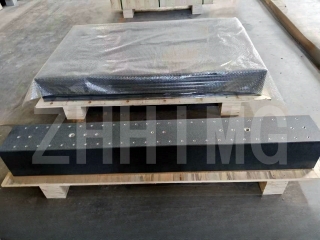The precision granite bed is an essential tool for many precision machining operations in various industries. It provides a flat and stable surface for measuring and aligning various tools and components with high accuracy. However, like any other instrument, the precision of the granite bed can degrade over time due to wear and tear, temperature changes, or other factors. Therefore, it's important to measure and calibrate the precision of the precision granite bed regularly to maintain its accuracy and reliability.
Here are the steps to measure and calibrate the precision of the precision granite bed:
1. Clean the surface: Before starting the measurement, clean the surface of the granite bed with a soft cloth and a mild cleaning solution to remove any dirt, dust, or oil residue. Even small particles or smudges on the surface can affect the accuracy of the measurements.
2. Choose the right gauge: Select the appropriate gauge or measuring tool for the type of measurements you want to perform. For example, if you need to check the flatness of the surface, you can use a precision straight edge or a surface plate level. If you want to measure the parallelism or perpendicularity of the sides or edges, you can use a dial indicator or a height gauge.
3. Establish the reference plane: Set up the reference plane or datum on the surface of the granite bed. This can be done by placing a known flat and straight object, such as a surface plate or a gauge block set, on the surface and adjusting it until it's aligned with the orientation you want to measure. This establishes the zero or reference point for the measurements.
4. Take the measurements: Use the selected gauge or measuring tool to perform the measurements on the surface, edges, or sides of the granite bed. Make sure to apply a consistent pressure and avoid any vibrations or disturbances that could affect the readings. Record the readings and repeat the measurements at different positions and orientations to ensure the accuracy and repeatability.
5. Analyze the data: Once you have collected the measurement data, analyze it to determine the precision of the granite bed. Calculate the range, mean, and standard deviation of the measurements and compare them to the desired tolerance or specification for the application. If the measurements are within the tolerance, the precision of the granite bed is acceptable. If not, you need to adjust or repair the bed accordingly to improve its precision.
6. Calibrate the bed: Depending on the results of the measurement analysis, you may need to calibrate the granite bed to correct any deviations or errors. This can be done by regrinding or lapping the surface, adjusting the leveling screws, or other methods. After the calibration, repeat the measurements to verify the new precision of the bed and ensure that it meets the required specification.
In conclusion, measuring and calibrating the precision granite bed is an essential task to ensure its accuracy and reliability in precision machining operations. By following the above steps and performing regular maintenance and calibration, you can prolong the lifespan of the bed and improve the quality and consistency of your products.
Post time: Feb-26-2024

